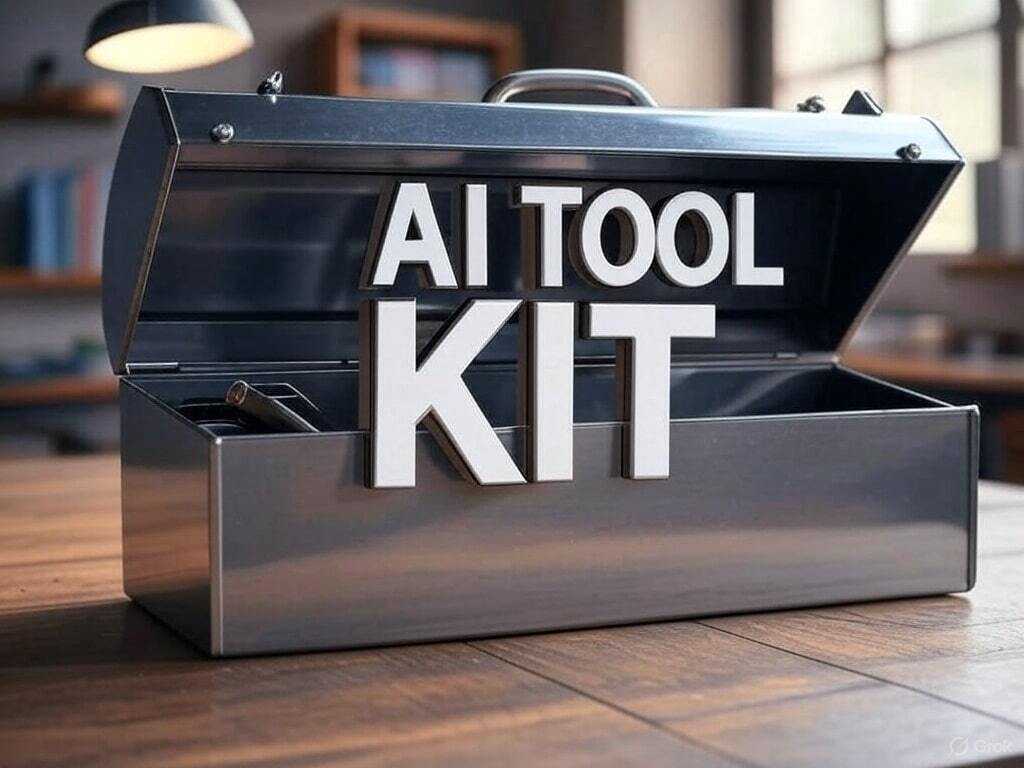- AI Biz Hour
- Posts
- GPT-5 vs. Grok: The AI Arms Race Accelerates While Horizon Beta Emerges as a Mystery Contender
GPT-5 vs. Grok: The AI Arms Race Accelerates While Horizon Beta Emerges as a Mystery Contender
AI Biz Hour Episode #196 - August 04, 2025

TODAY'S HIGHLIGHTS:
ChatGPT-5 set for August launch with unified architecture and improved reasoning capabilities
Grok AI reaches Tesla vehicles, transforming the in-car experience with conversational AI
The mysterious Horizon Beta model on OpenRouter shows impressive coding capabilities
Local LLM development accelerating with new tools like LM Studio's MCP support
Advanced context engineering techniques becoming essential for effective AI prompting
INTRODUCTION:
Welcome to the AI Biz Hour, where Andy Wergedal (@andywergedal) and John Allen (@AiJohnAllen) explore the cutting edge of AI business innovation. Today's discussion covered major developments in the AI landscape, from the upcoming GPT-5 release to the mysterious Horizon Beta model that's generating buzz among developers. The conversation also ventured into practical techniques for context engineering, model optimization, and working effectively with large codebases in AI-assisted development.
MAIN INSIGHTS:
The AI Model Arms Race Intensifies
ChatGPT-5 is expected to launch in August 2024, promising to unify ChatGPT and O-series models for the first time. According to Sam Altman, it will deliver near PhD-level reasoning capabilities across multiple domains. Meanwhile, Grok continues to push boundaries with Grok 4 already showing impressive results, and Grok 5 promising even more capabilities. As Andy noted, "The language they're using, the words they're saying, have a slight English nuance to them. But all that means to me is... Grok is ahead and pulling further ahead."
The LiveBench platform shows real-time benchmarking of these models, with Grok 4 scoring 97 for reasoning while Claude Sonnet reaches 95.25, indicating how tight the competition has become at the top tier of AI models.
Grok Reaches Tesla Vehicles
In a notable advancement, Grok AI is now integrated into Tesla vehicles via a July 2024 over-the-air (OTA) update. This feature enables conversational interactions through AccessBrock, a voice-driven interface offering various AI personalities. While it does not currently support vehicle control functions, Grok focuses on providing information and enhancing driver productivity.
Andy pointed out this deployment raises broader questions about voice interfaces: "Voice interfaces as a primary means of interaction with a compute system requires two things: It requires privacy so that you can ask questions... and it requires a space where others can't hear you." This suggests voice-driven AI could reshape workplace design and privacy considerations across industries.

The Mysterious Horizon Beta Model Emerges
Several participants discussed their experiences with Horizon Beta, a new AI model available on OpenRouter that's generating significant interest. According to Brad and Jason, this model shows impressive capabilities for coding tasks and appears to be related to OpenAI, with some speculating it could be a version or precursor of GPT-5.
Jason shared: "It's solving problems that I was having issues with... with other models, even Claude," though he noted it doesn't feel like the paradigm shift that some have hyped. The model reportedly has a 256,000-token context window with 128,000 output capacity and demonstrates unusual but effective problem-solving approaches.
Noah and others confirmed they've been testing it extensively: "I asked it to do something from a design perspective, and it understood immediately with just one very basic prompt." This indicates a level of intuitive understanding that's impressive even among top-tier models.
Local Development Tools Evolving Rapidly
The conversation highlighted significant advancements in local development tools, particularly LM Studio's addition of MCP (Model-Calling/Connecting Protocol) support. This enables users to run local models on their machines and connect them to external tools and data sources without extensive coding.
Andy explained how the plugin architecture is evolving: "They have one that will go search Duck Duck Go and get results, it'll find images, pictures, videos, it'll also do... you can put in a YouTube URL, and it'll do a transcript of the URL." This integration of search capabilities with local models represents a major step forward for developers seeking to reduce API costs while maintaining powerful capabilities.
Jason shared insights on the "Qwen3 30B" model that received a recent update, noting it's "very fast... and really good for coding." These developments suggest local AI development is accelerating dramatically, with more capabilities becoming accessible without cloud dependencies.
Context Engineering: The Evolution Beyond Prompt Engineering
One of the most valuable discussions centered on "context engineering" - an evolution from prompt engineering that focuses on how information is structured and presented to models. Jason provided an insightful explanation:
"People are calling it context engineering... because what you're doing is reassembling the context to be a narrative. These things are basically stateless... when you send messages up to these LLMs, you're having to always send the message history up."
He used a powerful analogy to explain the concept: "If I give someone a task to sort filing on my desk... send them into the office where there's all this other stuff to look at and be distracted with... that's what happens with models. Compare that to putting the person in a room with just the desk and three piles of paperwork... they're going to focus on that because they've got nothing else to distract them."
This approach can dramatically reduce hallucinations and improve model performance without requiring more powerful models. Simon added that context management becomes increasingly important as you scale from personal use to professional services: "Once you start offering these services... you are going to be paying for a lot of that context. If you can provide a service more efficiently, then you're going to directly affect your bottom line."
Working Effectively With Large Codebases
The group shared valuable techniques for helping AI tools understand and work with large codebases. When Real Lucas asked about best practices, Jason recommended: "If it's a Git repo, run it through something like git ingest... that will turn the whole repo into one big text file." This allows developers to feed the entire codebase to models with larger context windows like Gemini, creating an instant knowledge base about the project.
For codebases that exceed token limits, Jason suggested: "I summarize it down... can you summarize this whole file down without losing any of the quality or the detail of specific code?" He noted that models are remarkably good at preserving the essential information while reducing the "fluff."
Brad added that Abstract Syntax Trees (ASTs) can be valuable: "If you convert your code into an abstract syntax tree, that will strip out all the white space and all the comments... and you can use that to compress the codebase." This approach enables semantic searching rather than simple keyword matching, making it easier for models to understand code relationships.
FEATURED TOOLS & TECHNIQUES:

LM Studio with MCP Support
LM Studio now offers Model-Calling/Connecting Protocol support, allowing users to run local models and automate API connections. This enables the creation of agentic workflows without extensive coding, facilitating connections between local LLMs and external tools.
Horizon Beta on OpenRouter
Available through OpenRouter, this mysterious model shows exceptional reasoning and coding capabilities. With a 256,000 token context window and 128,000 token output capacity, it's generating significant interest in the developer community as a potential OpenAI model.
Open Code
An open-source alternative to Claude Code that allows users to select their preferred models. Nathan described it as "native" with a good command-line interface while offering flexibility in model selection that proprietary options lack.
Kylo Code
Jason recommended this tool as a combination of other coding assistants, noting "it's a combination of both [Cline and Ruby], and I'm liking that a lot at the moment."
AST Grep
Brad recommended this tool for working with Abstract Syntax Trees, which can significantly improve code analysis and compression for AI model consumption.
Context Optimization Techniques
Hooks/Triggers: Jason highlighted the importance of hooks for intercepting events in AI workflows: "Hooks are going to be the big thing... you're intercepting it every single time, and so you've got a reliable way to do things like extract logs, extract information for training."
Checkpoint Summaries: Regularly asking models to summarize the current progress helps maintain context clarity: "Could we summarize where we are? You know, could we get a checkpoint on where we are so far?"
The "Two Not Three" Technique: Umesh's approach involves asking for two ideas initially, then requesting a third while instructing the model to discard one of the original two. This forces a structured elimination process, leading to higher-quality outputs.
QUICK HITS:
When working with new models, test their capabilities with specific tasks rather than general questions
Consider using OpenRouter to access a wide range of models, including experimental ones like Horizon Beta
For large codebases, create summary documents that extract coding style, patterns, and best practices
Use "lessons learned" documents to help models understand past solutions to complex problems
Be precise with terminology when communicating with models to avoid confusion
Avoid leading questions as models tend to agree with suggestions rather than provide objective answers
Set up file watchers to automatically review code changes as they happen
Be cautious when models respond with "let me try a different approach" - this often signals a problem
RESOURCES MENTIONED:
LiveBench: Real-time benchmarking platform for LLM performance
LM Studio: https://lmstudio.ai/
Open Router: https://openrouter.ai/
Open Code: Open-source alternative to Claude Code
Quinn 330B: Local model with recent performance improvements
AST Grep: Tool for working with Abstract Syntax Trees
Taskmaster: Project management tool with MCP support (thousands of GitHub stars)
COMING UP:
Join us for tomorrow's live AI Biz Hour session at 12 PM ET!
CONNECT WITH AI BIZ HOUR:
Website: aibizhour.com Andy: @andywergedal John Allen: @AiJohnAllen Show: @aibizhour
CALL TO ACTION:
Don't miss out on future insights! Join the AI Biz Hour community and subscribe to the newsletter at aibizhour.com to stay ahead in the world of AI business innovation. Follow the hosts and regular contributors on X to continue learning from the best minds in AI.
OUR SPONSOR Gov Bid Mike

Looking to tap into the $7 trillion government contracting market? GovBidMike helps businesses secure government contracts and grants. With important AI procurement rule changes coming in October 2024, now is the time to position your business. Mention AI Biz Hour for a 10% discount on services. Government contracts increasingly specify American-made AI technologies and interoperability requirements. Visit biddata.ai to learn how to navigate the complex world of government procurement.
Join us tomorrow for our next live session at 12 PM ET!
Reply